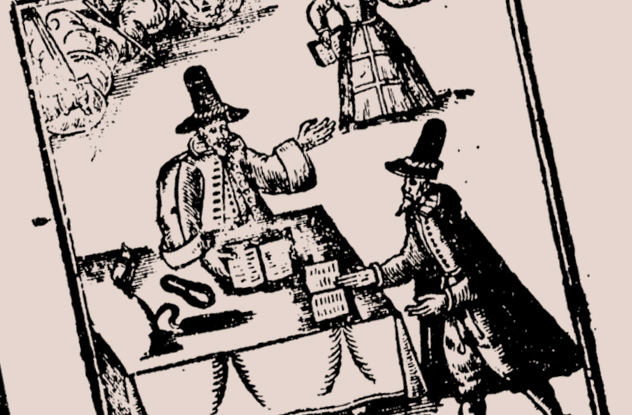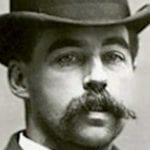 Weird Stuff
Weird Stuff  Weird Stuff
Weird Stuff  Health
Health Ten Confounding New Inventions from the World of Biomedicine
 Creepy
Creepy 10 Death Superstitions That Will Give You the Creeps
 Movies and TV
Movies and TV 10 Movies That Get Elite Jobs Right, According to Experts
 Weird Stuff
Weird Stuff 10 Times Real Laws Were Based on Bizarre Hypotheticals
 Animals
Animals 10 Inspiring Tales of Horses Being Human
 Mysteries
Mysteries Top 10 Haunting Facts About the Ghost Ship MV Alta
 History
History 10 Surprising Stories About the Texas Rangers
 Humans
Humans 10 Philosophers Who Were Driven Mad by Their Own Theories
 Miscellaneous
Miscellaneous 10 Video-Game-Worthy Weapons and Armors from History
 Weird Stuff
Weird Stuff 10 Warning Labels That Exist Because Someone Actually Tried It
 Health
Health Ten Confounding New Inventions from the World of Biomedicine
 Creepy
Creepy 10 Death Superstitions That Will Give You the Creeps
Who's Behind Listverse?

Jamie Frater
Head Editor
Jamie founded Listverse due to an insatiable desire to share fascinating, obscure, and bizarre facts. He has been a guest speaker on numerous national radio and television stations and is a five time published author.
More About Us Movies and TV
Movies and TV 10 Movies That Get Elite Jobs Right, According to Experts
 Weird Stuff
Weird Stuff 10 Times Real Laws Were Based on Bizarre Hypotheticals
 Animals
Animals 10 Inspiring Tales of Horses Being Human
 Mysteries
Mysteries Top 10 Haunting Facts About the Ghost Ship MV Alta
 History
History 10 Surprising Stories About the Texas Rangers
 Humans
Humans 10 Philosophers Who Were Driven Mad by Their Own Theories
 Miscellaneous
Miscellaneous 10 Video-Game-Worthy Weapons and Armors from History
10 Communist Societies That Predated The USSR
Karl Marx outlined his theories of a classless society with common ownership in his 1848 pamphlet The Communist Manifesto. Russia, under Lenin, first implemented this plan on a large scale. But the idea of such a society was not new. Throughout history, various people have organized themselves along communist principles.
10Prehistoric Humans

In a world where the production of goods was low, yielding little beyond what everyone needed, people did not use one another for profit. Humans lived by hunting and gathering, and the only division of labor was biologically based: The physically stronger males hunted for food, while the women took care of domestic tasks and raising children. Hunting was a collective activity, and spoils were therefore common property. In a world where everyone was struggling to survive, sharing basic needs was the norm.
The only private property to speak of were the huntsman’s tools, and these were ordinarily buried with the body at death. There was no concept of “the state.” Classes didn’t exist. Quarrels were among individuals, and they were settled by the tribe. Old men played a decisive role in this process due to their experience, but they were not leaders in the usual sense of the word. Their role was exemplified by Athanaric, a later Visigoth leader, who as recently as the third century A.D. said, “I have authority, but not power.”
This was the human condition for 99 percent of the time that the species has inhabited the planet. The Neolithic agricultural revolution changed all that. Now it was possible to produce a surplus. As humans settled in fixed habitations, division between property-owning and laboring classes appeared.
9Pythagoreans

The Greek philosopher Pythagoras established a communist experiment in Croton in southern Italy, combining a university and a monastic order. The Pythagoreans were mystics who believed in a harmonious physical and moral universe ordered by numbers. They believed that private property destroyed this harmony and created social injustice. For Pythagoras, merely enjoying comfort and wealth while others endured privation was a grave sin.
The inner-circle members of Pythagoras’s society, the mathematikoi, rejected private property and were strict vegetarians. According to Plato, Pythagoras said, “Friends share everything” and “Friendship is equality.” His disciples even shared personal items like eating utensils. The outer circle, the akousmatics, were allowed their own possessions. The Pythagoreans were notable for being the only ancient sect, apart from the Platonists, who permitted women into the society and treated them as full equals of men.
Novices allegedly took a vow of silence for five years. It would seem that speech, so cherished by mainland Greeks, was discouraged in the community. In fact, the Pythagoreans were so secretive about their beliefs and practices that Pythagoras himself left no written work behind. Thus, we are left mystified by some of the more baffling points of his doctrine, like his prohibition of beans. It has been speculated that Pythagoras had an aversion to beans because they were shaped like fetuses, because they induce flatulence, or because Greek oligarchies used them for voting.
The Pythagorean movement spread rapidly around the end of the sixth century B.C. and even became politically influential. The radical communist reorganization of society aroused the hostility of the propertied class. It was violently suppressed in 510 B.C. when the tyrant Cylon drove the Pythagoreans out of Croton. The communist ideas of Pythagoras survived, however, and influenced Plato in The Republic, his treatise on the ideal society.
8Sparta

Athens is known as the cradle of democracy, and her clashes with communistic Sparta foreshadowed a certain 20th-century superpower rivalry. The Spartan system of government was designed to make the city-state an efficient military machine, and the individual was only important as a tool of the state.
All Spartans considered themselves equal. Though Spartans did have some private family property, most land was handed out by the state. The division of lots of the same size, devised by Spartan reformer Lycurgus, inspired later agrarian communist movements.
To discourage citizens from acquiring wealth, Lycurgus decreed that iron, not gold or silver, would be Spartan currency. Since iron coins had no real value outside of Sparta (and weighed a lot), Spartans actually had no monetary wealth to speak of. The proscription against accumulating wealth had the effect of making sons turn to the state for material support, rather than to their families. The machine, in turn, molded them into fierce fighting warriors totally dedicated to the state. In fact, Lycurgus made soldiering the only legal occupation open to Spartan males.
While some historians label Spartan society as communist, it departed from strict communism by being stratified into classes. Two kings ruled the city, their powers circumscribed by a 28-member Council of Elders. In the highest social class were the aristocratic Spartiates, the citizen-warriors who lived most of their lives in communal barracks. The Perioeci made up a middle class of non-citizen farmers and artisans, and the helots were the bottom slave class.
7Essenes

The Essenes were a pre-Christian Jewish sect with communities around the Dead Sea region, the most famous of which is Qumran, where the Dead Sea Scrolls were discovered. The Essenes separated themselves from mainstream Jewish society in reaction against what they perceived as its growing worldliness and corruption. They considered themselves the righteous remnant, the true elect of God, dedicating their lives to purity, virtue, and strict observance of the Law of Moses. Their zeal for the Law was such that they would not even defecate on the Sabbath, according to the historian Josephus.
The Essenes were an apocalyptic sect that anticipated a coming war of the Sons of Light against the Sons of Darkness. Their asceticism prepared them for this cosmic final conflict, on which they would be holy warriors on God’s side as the Sons of Light. But in the real world, they were pacifists, refusing even to carry weapons.
There were no women in the community. Inner-circle Essenes appeared to be celibate. Converts gave up all their possessions to the common treasury, taught to despise riches and instead live a life of voluntary poverty. Clothes and sandals were used until worn out. Having servants was forbidden. Members lived communally as a family of equals, and leaders were elected.
The Essenes mastered farming and agriculture to such a degree that they were able to grow crops in the arid region sufficient for entire communities. They used sophisticated drip irrigation systems and saved rainwater in huge cisterns. Harvests were handed over to stewards and were distributed according to need.
Members worked in these communal farms and made their own implements and household tools. Trading was confined to barter. From the common storehouse, members aided the sick who couldn’t contribute their share.
The Romans destroyed Qumran in A.D. 68 during the Jewish revolt, and it was never resettled.
6Early Christianity

So many points of similarity have been noticed between Essene doctrine and Christianity that some have proposed that Jesus was actually an Essene. He tells a rich young man in Mark 10:21 to “go, sell whatsoever thou hast, and give to the poor, and thou shalt have treasure in heaven; and come, follow me.” In Acts 2:44–45, we read that the early Jerusalem church practiced communism. “And all they that believed were together and had all things common. Their possessions and goods they sold, and divided them to all, according as every one had need.”
The simplicity of primitive Christianity did not last, as the Church accommodated itself to the economic and social structure of the Roman Empire. But the concept of communism endured within its monastic communities, which spread throughout Egypt and Asia Minor in the second and third centuries. Within their walls, monks held all material goods in common and humbly served one another in imitation of Christ. Early Christian monasticism stressed severe asceticism and disdain of luxuries.
In the West, St. Benedict relaxed the severity and discipline of monastic life, allowing monasteries to own property. However, his famous rule still retained distribution of goods “to each according to need.” Benedict, a former student of law, considered the monastery a corporation, where monks led a temperate life divided between work, sleep, and prayer.
They wore standard clothing drawn from a common store. An abbot was in charge of the monastery, but his decisions were made in consultation with the rest of the monks. His authority derived from his office and not his person. All monks were equal in status, whether they came from the nobility or peasantry. Once they entered the doors of the monastery, they were in effect born again, leaving behind their former lives.
While people in the outside world strove for wealth and influence that would allow them to avoid work, Benedict commanded that all monks must work. Joyously performed, work was considered praise for God.
With the passing of time, these monastic corporations became beneficiaries of land and riches. Ironically, the great abbeys of the Middle Ages rivaled the feudal estates of lay lords in wealth and influence.
5Zandiks

The Zandiks were members of a movement in the mid–fifth century seeking to reform the Zoroastrian religion of Persia and its powerful and wealthy clergy. It was led by a priest named Mazdak, who preached social justice and equality. He taught that God intended material goods to be shared equally. But since that ideal had degenerated into exploitation of the weak to gain property, Mazdak taught that it became necessary to rob the rich to help the poor and thus equalize the system.
The Zandiks raided storehouses to redistribute the food to the poor, threatening the property of the rich. Mazdak saw such actions as necessary to overcome the Five Demons—Envy, Wrath, Vengeance, Need, and Greed—that turned people to darkness.
Mazdak proposed ways to break up the large estates, prohibit hoarding, remove class distinctions, and set up public charities. He was accused of promoting sharing wives in common, but it is likely that what he was really against was the hoarding of wives in harems and the practice of polygamy. In Mazdakite society, women were on an equal footing with men.
The Sassanid ruler of Persia, Khosrau, lured Mazdak and his followers ostensibly to a religious debate and banquet in his honor at the capital of Ctesiphon. But instead, Mazdak and 3,000 of his people were seized when they arrived. Mazdak was forced to watch as his followers were buried alive headfirst before he himself was hung upside down and shot with arrows.
4Taborites

Jan Hus, a teacher at Prague University, protested the increasing worldliness of the Church, pointing to social and economic chaos in Bohemia as a sign of the imminent arrival of the Antichrist. His unrelenting attacks on the Church marked Hus as a heretic, and he was burned at the stake in 1415.
His followers, the Hussites, thereafter split into the moderate Utraquists and the extremist Taborites. The Taborites were named after the city of Tabor, which they founded and where they sought to prepare themselves spiritually for the end of the world. The Taborites established a utopian society based on the axiom “neither mine nor thine”—rejection of private property.
The Taborite Articles of 1420 clearly spelled out: “No longer shall there be a reigning king or a ruling lord; for there shall be servitude no longer. All taxes and exactions shall cease and no one shall compel another to subjection. All shall be equal as brothers and sisters. As in the town of Tabor there is no mine or thine, but all is held in common, so shall everything be common to all, and no one own anything for himself alone. Whoever does so commits a deadly sin.”
The Taborites elected their bishops, who were dependent on the community for their needs. The Taborites gave great importance to popular education. But the tiny utopia did not enjoy much peace. The Catholic Church had launched a crusade against the heretics, and the bloody Hussite Wars dragged on for years.
Even within Tabor, divisions were appearing. One faction, the Adamites (Pikarti in Czech), believed that they were beyond sin, having returned to the innocence of Eden. They advocated free love and declared marriage as sinful. They performed their rituals in the nude, and nudity in daily life was preferred. They were suppressed in 1421.
Spoils taken in battle also added material wealth to Tabor, and this caused greed and envy to emerge among the inhabitants. There began to be richer and poorer members, with the former becoming less willing to share their surplus. The idyllic equality was eroding.
The Catholics, now allied with the Utraquists, finally inflicted a crushing defeat on the Taborites at the Battle of Lipany in 1434, ending the extremist sect’s existence.
3Anabaptists

The Anabaptists (Anabaptist means “one who baptizes over again”) believed themselves the predestined elect. The sect’s extreme wing sought to seize political power to shape society according to its creed. Its first leader was Thomas Muntzer, who was influenced by Hussite communism and set out to spread the ideology through fire and sword across Germany. Even Martin Luther, whose Protestant movement unleashed an explosion of sects, deemed Muntzer a very dangerous man.
By 1523, Muntzer had gained the allegiance of a large group of uneducated Thuringian miners, which he transformed into a revolutionary organization called “The League of the Elect.” Muntzer was able to take over the city of Mulhausen in 1525, where he imposed a communist regime by seizing monasteries and abolishing private property. As a result, “he so affected the folk that no one wanted to work,” according to one contemporary.
Communism became the justification for outright theft. “When anyone needed food or clothing, he went to a rich man and demanded it of him in Christ’s name, for Christ had commanded that all should share with the needy. And what was not given freely was taken by force. Many acted thus . . . Thomas [Muntzer] instituted this brigandage and multiplied it every day.”
After Muntzer’s capture and execution during the Peasants’ War, he was succeeded by Hans Hut, who promised God’s vengeance on priests, kings, and nobles. Christ, he preached, would return in 1528 and usher in a millennium of communism and free love.
Hut was captured in 1527 and killed while trying to escape, but his movement refused to die. In 1534, the Anabaptists seized the city of Munster. All non-Anabaptists, including pregnant women, babies, and the elderly, were expelled in the midst of a raging snowstorm. Their properties were seized and turned over to central depots. Wages were paid in kind by the only employer that remained in Munster—the communist government. Eventually, the regime imposed forced labor, with all artisans working for the community for no reward whatsoever.
Private homes were communized. It was illegal to lock—or even close—one’s door. All books except the Bible were prohibited, and massive book-burnings followed by mobs of revolutionaries. By degrees, the once-puritanical Anabaptists first enjoined polygamy, allowed divorce, forbade marriage altogether, and finally embraced free love and total promiscuity.
Every protest and behavior that met the disapproval of the regime, like women refusing sex with their partners, was punishable by death. All the while, the Catholics were besieging the city, blockading it and cutting off its food supply. While the people starved, the ruling elite feasted on confiscated food. Some accounts tell of their lavish and debauched lifestyle. Munster, the Anabaptist “New Jerusalem,” had become a living hell.
At last, two inhabitants managed to escape the city and lead the besiegers to the weak points in its defense. On June 25, 1535, the Catholics finally broke through, massacring the defenders and executing the Anabaptist leaders. The nightmare of the Great Communist Experiment was over.
2Diggers

The aftermath of the English Civil War brought widespread unemployment and hunger due to bad harvests. Against this backdrop of economic and social instability, a movement to abolish private property and secure common ownership of land spread through southern and central England.
The agrarian communists were called Diggers, and they saw the removal of the monarchy and the establishment of the Commonwealth as the first step in the process of wresting land away from the nobility and gentry. In 1648, a pamphlet titled Light Shining in Buckinghamshire called for the overthrow of the nobility and equalization of wealth. A sequel sought support from the army.
The Diggers declared the world as “common treasury.” The hungry and destitute began cultivating waste and public land. Digger communities sprang up, the most prominent being St. George’s Hill and Cobham Heath in Surrey. It was hoped that the poor soil at George Hill (renamed since the Diggers repudiated the saints of the established church) could be made productive by practical agricultural techniques.
The radical notions of the Diggers were disowned by the more moderate Levellers who worked for reform within the existing social structure. The Diggers designated themselves the “True Levellers,” but their ideas of equality aroused the hostility of the gentry and gained no sympathy from the Commonwealth government. They were harassed with legal actions, boycotts, and direct violence. Digger settlements were burned down, and their crops were destroyed. By the end of 1650, the movement had been effectively suppressed.
1Shakers

In August 1774, a penniless English mystic named Ann Lee and nine companions arrived in New York, determined to pursue Lee’s vision of a New Eden in America. While in England, they had suffered persecution for their unorthodox doctrines and practices. They held rites where spiritual ecstasy led members to hysterical dancing, singing, and shaking, so the world pejoratively called them “Shaking Quakers” or simply “Shakers.” They called themselves the United Society of Believers in Christ’s Second Appearing.
In America, “Mother Ann” Lee found ready converts among those caught up in the “Great Awakening” religious revival. The first Shaker community was established in Niskayuma, New York. Mother Ann kept a low profile at first with her apocalyptic preaching. But on May 19, 1780, a strange and terrifying darkness descended on New England, making noon as black as night.
The cause wasn’t supernatural—there were wildfires out in Canada—but people thought Judgment Day had come. Hundreds thronged around the Shakers who had been predicting these things. With more converts, Shaker settlements spread across New England, south to Kentucky and west to Indiana. The two cornerstones of these communities were celibacy and communism.
All four of Mother Ann’s children died in infancy, and in her grief, she concluded that sex was evil. Ann insisted on celibacy among her followers. Shaker men and women were kept separate at all times to avoid sexual temptation. Theirs was a simple lifestyle of work and prayer, separate from the world. They lived in dormitory-like housing, and the Shakers became well known and admired for the clean, economic lines of their crafts. They believed that God dwelled in the details of their work.
Shakers were not afraid of innovation and technology. The clothespin, the circular saw, and hundreds of similar laborsaving devices are Shaker inventions that they shared with others and never bothered to patent. In New Hampshire, they owned one of the first cars in the state and had electricity in their village when the state capital was still using gaslight.
Shaker colonies were, and still are, showcases of neatness and order. In these serene villages, converts who gave up marriage, family, and property came “to know, by daily experience, the peaceable nature of Christ’s kingdom.” Here, the races as well as the genders were equal. In 1817, Shakers in the South freed their slaves and bought black believers from their masters.
But their celibacy, and the resulting lack of children, spelled doom for the Shakers, as they had to rely on converts to maintain their existence. Their numbers dwindled as America became more secular and offered more diversity and opportunity than the Shaker utopia. One of the last communities to close was Hancock Village in Massachusetts, which became a ghost town in 1960 and is now a museum. The last surviving Shakers still live in Sabbathday Lake, Maine.
Larry’s main interests are history and chess. His book The Chess Workout is available on Amazon.




